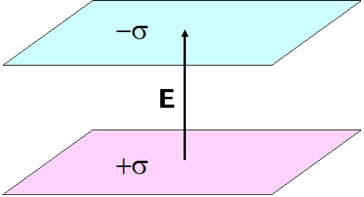Capacitance
Level 0 (green)- this is basic material that you have probably encountered already, although the approach may be slightly different. No prior knowledge is assumed.
Capacitors are useful charge storage devices, used if a large charge is required to be discharged rapidly, as in some types of laser. Capacitors have many other uses in electronics. In chemistry the capacitance of a double layer has applications in electrochemistry and colloids.
Consider a system of two plates with charge densities per unit area +σ and –σ. If each plate has area A, the charge on each plate is ±Q = ±σA. Such a system is said to store charge Q. From the previous section, the potential difference between the plates must be |
 |
The capacitance is defined as the charge stored divided by the potential difference
![]()
In the case of parallel charged plates this is equal to
![]()
Notice that this is simply a property of the plates (their area and the distance between them) and the medium between the plates (via the dielectric constant). That is we can work out the capacitance for any physical setup, and it does not depend on the potential difference.
It requires energy to charge a capacitor, this energy is the work required to charge one plate at the expense of the other.
The work required to move an infinitesimal amount of charge dq from one plate to the other if the potential difference between the plates is V is equal to
![]()
However, as the capacitor is charged, the potential difference changes, because
![]()
and C is a constant, so the work needed to move dq from one plate to the other in a given system is
![]()
Integrating, the work required to charge a capacitor from 0 to Q is

This quantity is sometimes referred to as the energy stored in the capacitor.
